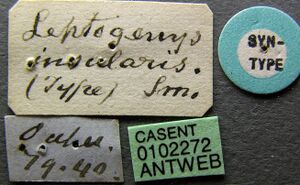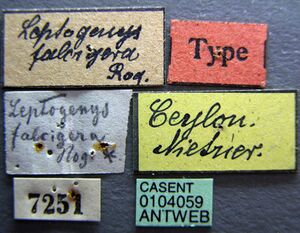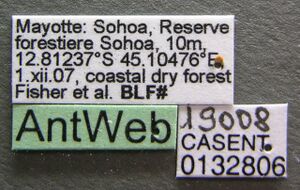Leptogenys falcigera
| Leptogenys falcigera | |
|---|---|

| |
| Scientific classification | |
| Kingdom: | Animalia |
| Phylum: | Arthropoda |
| Class: | Insecta |
| Order: | Hymenoptera |
| Family: | Formicidae |
| Subfamily: | Ponerinae |
| Tribe: | Ponerini |
| Genus: | Leptogenys |
| Species group: | maxillosa |
| Species: | L. falcigera |
| Binomial name | |
| Leptogenys falcigera Roger, 1861 | |
| Synonyms | |
| |
Leptogenys falcigera is widespread but not common in the Malagasy region. This species generally occupies coastal areas and disturbed habitats in each island of the region and is thought to be introduced. In Madagascar, it is the dominant ponerine ant in the spiny forest/thicket habitat of the southern tip of the island. The dominance of this species in the south suggests that the species may be native or arrived on this island long ago, or recently introduced and rapidely spread in this type of habitat. The species was able to survive and dominate this southern region because environmental factors here resemble its place of origin. Workers of L. falcigera forage on the forest floor, in leaf litter, and on lower vegetation, and nest in live tree stems, in dead twigs or branches above the ground, and in rotten logs. (Rakotonirina and Fisher 2014)
| At a Glance | • Invasive |
Identification
A member of the maxillosa species group. Rakotonirina and Fisher (2014) - Worker. Mandible not closing tightly against broadly convex anterior clypeal margin; dorsum of body without standing hairs, but covered with very dense pubescence; sculpture shagreenate; anterior margin of clypeus covered with narrowly angulate translucent lamella; three peg-like setae usually projecting anteriorly from median border of clypeus; in dorsal view petiolar node longer than broad or as long as broad.
This species is very similar to Leptogenys maxillosa but can be easily separated by its elongate and narrower petiolar node (L. falcigera: DNI: 93–109; L. maxillosa: DNI: 113–133). Leptogenys falcigera can be distinguished from Leptogenys pavesii by the narrow and medially obtuse translucent lamella fringing its median clypeal lobe and the presence of three peg-like setae projecting anteriorly from the anterior margin of the median lobe. In L. pavesii, this fringing lamella is wide and broadly rounded and two peg-like setae project anteriorly from the anterior margin of the median lobe of the clypeus
Keys including this Species
- Key to Malagasy Leptogenys
- Key to Micronesian Ants
- Key to Oriental Leptogenys
- Key to Afrotropical Leptogenys workers
Distribution
Distribution based on Regional Taxon Lists
Afrotropical Region: Comoros.
Indo-Australian Region: Guam, Hawaii, Marshall Islands, Micronesia (Federated States of), Northern Mariana Islands, Palau, Philippines.
Malagasy Region: Madagascar, Mauritius, Mayotte.
Oriental Region: India, Nepal, Sri Lanka (type locality).
Distribution based on AntMaps
Distribution based on AntWeb specimens
Check data from AntWeb
Countries Occupied
| Number of countries occupied by this species based on AntWiki Regional Taxon Lists. In general, fewer countries occupied indicates a narrower range, while more countries indicates a more widespread species. |

|
Estimated Abundance
| Relative abundance based on number of AntMaps records per species (this species within the purple bar). Fewer records (to the left) indicates a less abundant/encountered species while more records (to the right) indicates more abundant/encountered species. |

|
Biology
|
Castes
Images from AntWeb
   
| |
| Worker. Specimen code casent0102271. Photographer April Nobile, uploaded by California Academy of Sciences. | Owned by NHMUK, London, UK. |
   
| |
| Lectotype of Leptogenys insularis. Worker. Specimen code casent0102272. Photographer Shannon Hartman, uploaded by California Academy of Sciences. | Owned by NHMUK, London, UK. |
    
| |
| Type of Leptogenys falcigera. Worker. Specimen code casent0104059. Photographer April Nobile, uploaded by California Academy of Sciences. | Owned by ZMHB, Berlin, Germany. |
   
| |
| Worker. Specimen code casent0132806. Photographer Erin Prado, uploaded by California Academy of Sciences. | Owned by CAS, San Francisco, CA, USA. |
Nomenclature
The following information is derived from Barry Bolton's Online Catalogue of the Ants of the World.
- falcigera. Leptogenys falcigera Roger, 1861a: 42 (w.) SRI LANKA. Forel, 1891b: 111 (m.). Senior synonym of insularis: Wilson & Taylor, 1967: 30. See also: Bolton, 1975a: 252.
- insularis. Leptogenys insularis Smith, F. 1879: 675 (w.) HAWAII. Forel, 1899a: 118 (m.). Subspecies of falcigera: Forel, 1899a: 118. Junior synonym of falcigera: Wilson & Taylor, 1967: 30.
Unless otherwise noted the text for the remainder of this section is reported from the publication that includes the original description.
Description
Worker
Rakotonirina and Fisher (2014) - (16 specimens). HW: 1.41–1.66, HL: 1.42–1.69, CI: 96–105, SL: 1.34–1.58, SI: 90–100, PW: 0.94–1.10, WL: 2.29–2.73, PNH: 0.76–0.90, PNL: 0.65–0.80, PNW: 0.66–0.80, DNI: 93–109, LNI: 109–122.
Head broader than long, increasing in width to front, sides slightly convex and diverging anteriorly along length. Eye large, maximum diameter greater than widest portion of scape; extending beyond lateral edge of head in full-face view. Anteromedian lobe of clypeus borderedby narrow and obtusely angulate translucent lamella; usually three and rarely two or four peg-like setae projecting anteriorly at anterior margin of median lobe at base of lamella. Mandible slightly curved near base and become roughly straight apically; preapical tooth or denticle of mandible either absent or present near apical tooth. In dorsal view, petiolar node most often longer than broad and infrequently as long as broad. Dorsum of head, mesosoma, petiolar node, and third and fourth abdominal segments without standing hairs; whitish yellow pubescence very abundant. Head and body with dense shagreenate sculptures, interspersed with larger punctures. Black species with lighter tip of gaster; appendages dark brown to reddish brown basally and brown to light brown toward apex.
Type Material
Rakotonirina and Fisher (2014) - Holotype worker, Sri Lanka (H. Nietner) [location of type not known]. F. Smith’s worker type specimen is located at The Natural History Museum and was examined during the course of this study; it bears a blue syntype label in concordance with Smith’s description that the type-series includes several workers: “Not rare,..., workers only taken”. Conversely, the BMNH Accessions register only indicates a single specimen was deposited: “1879 no. 40. 1 Leptogenys insularis Sm. Sandwich Is (Oahu), presented by Rev. T. Blackburn, Honolulu”. Though this may imply that additional syntypes may not exist, and that the single specimen at BMNH is a holotype, we nonetheless designate this specimen as the lectotype.
The following notes on F. Smith type specimens have been provided by Barry Bolton (details):
Leptogenys insularis
Holotype worker in The Natural History Museum. Labelled “52” upon the stage card, and “Oahu. 79/40.” Acc. Reg.: “1879 no. 40. 1 Leptogenys insularis Sm. Sandwich Is (Oahu). Presented by Rev. T. Blackburn, Honolulu.” A blue syntype label is on the specimen (as opposed to a red holotype label) as the type-series appeared originally to contain several workers. Smith says, “Not rare,......workers only taken.” On the other hand, the specimen may well be unique as the accessions register specifically states “1.”
References
- Bolton, B. 1975a. A revision of the ant genus Leptogenys Roger (Hymenoptera: Formicidae) in the Ethiopian region with a review of the Malagasy species. Bull. Br. Mus. (Nat. Hist.) Entomol. 31: 235-305 (page 252, see also)
- Forel, A. 1891c. Les Formicides. [part]. In: Grandidier, A. Histoire physique, naturelle, et politique de Madagascar. Volume XX. Histoire naturelle des Hyménoptères. Deuxième partie (28e fascicule). Paris: Hachette et Cie, v + 237 pp. (page 111, male described)
- Rakotonirina, J.C. & Fisher, B.L. 2014. Revision of the Malagasy ponerine ants of the genus Leptogenys Roger (Hymenoptera: Formicidae). Zootaxa 3836, 1-163.
- Roger, J. 1861a. Die Ponera-artigen Ameisen (Schluss). Berl. Entomol. Z. 5: 1-54 (page 42, worker described)
- Subedi, I.P., Budha, P.B., Bharti, H., Alonso, L. 2020. An updated checklist of Nepalese ants (Hymenoptera, Formicidae). ZooKeys 1006, 99–136 (doi:10.3897/zookeys.1006.58808).
- Subedi, I.P., Budha, P.B., Bharti, H., Alonso, L., Yamane, S. 2023. Ponerine ants of Nepal (Hymenoptera: Formicidae, Ponerinae): a generic synopsis, new faunal records, and rediscovery of a rare ant, Emeryopone franzi (Baroni Urbani 1975). (doi:10.20362/am.016003).
- Subedi, I.P., Budha, P.B., Yamane, S. 2022. Ants of the genus Leptogenys Roger, 1861 (Hymenoptera: Formicidae, Ponerinae) from Nepal. Far Eastern Entomologist 448: 11-20 (doi:10.25221/fee.448.2).
- Wilson, E. O.; Taylor, R. W. 1967b. The ants of Polynesia (Hymenoptera: Formicidae). Pac. Insects Monogr. 14: 1-109 (page 30, Senior synonym of insularis)

